This is one story of several inspired by the music on a barrel-organ which Admiral Sir William Edward Parry took to the Arctic journeys between 1819 and 1825. I have been looking at this material for a couple of years now, and this article is the first one out of the treasure chest! Please see the foot of this page for credits for this original research.
About two thirds of the 40 items on Parry’s barrel-organ are dance tunes, with some hymns and patriotic songs. Dancing was an incredibly popular pastime in that period for people of all classes, mostly done with a partner in a longways formation, and tunes for the dances proliferated with the expansion of printing, being the equivalent of buying recorded music in the twentieth century.
The tunes on the barrel-organ are absolutely typical of the period, including English and Scottish reels, with just two jigs, both with distinctly Irish sounding names: Paddy Carey, which is a staple of the English session repertoire these days, and Paddy O’Rafferty, a well-known tune in the Irish repertoire, which I decided to investigate in some depth. Rather than go in strictly chronological sequence, I’m going to look at some of the various incarnations of the entity that is Paddy O’Rafferty, starting with the dance tune (and a passing mention of the dance itself). If you’re interested in the chronology of its early history, there’s one at the end of this article.
So here begins the interesting and complex back story for the multi-faceted Paddy O’Rafferty.
Dance tune (and dance)
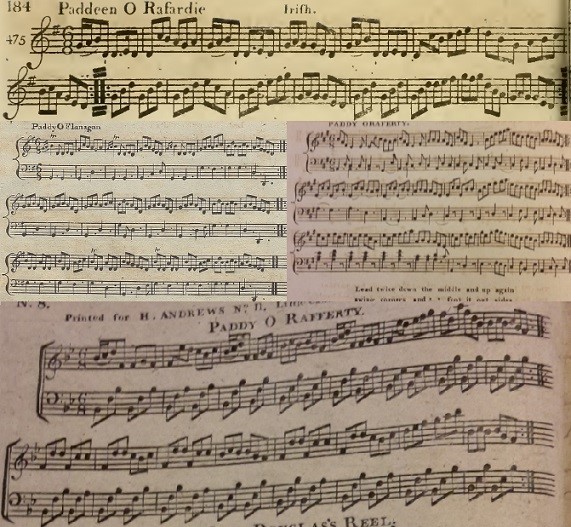
In 1795 a tune by this name was collected from the playing of a Mr. J.McCalley of Balleymoney, Co. Antrim by Edward Bunting. A year later, a jig Paddeen O Rafardie was published in Glasgow by James Aird: that’s the one at the top here. In the middle you can also see very brief dance instructions – the dances were all in the same longways configuration and the figures were very formulaic.
From 1801 the tune was enormously popular as a dance tune at balls for the “nobility and gentry” when it often featured as the first or second dance of the evening.
The lack of copyright legislation (more of that later) allowed for frequent republishing of the tune and it turns up in dance and tune publications very regularly – as can be seen here – in many different settings; from two parts up to five parts, usually with something in common with other versions!
This image comes from the brilliant Regency Dances website – see below for the link.
The folk song
So far, so relatively simple, despite the large number of variations on the tune.
There is also a song by this name, so next I began to investigate the Vaughan Williams Memorial Library and the Irish Traditional Music Archive, the Bodleian Library and other places where we are used to searching for “folk” songs.
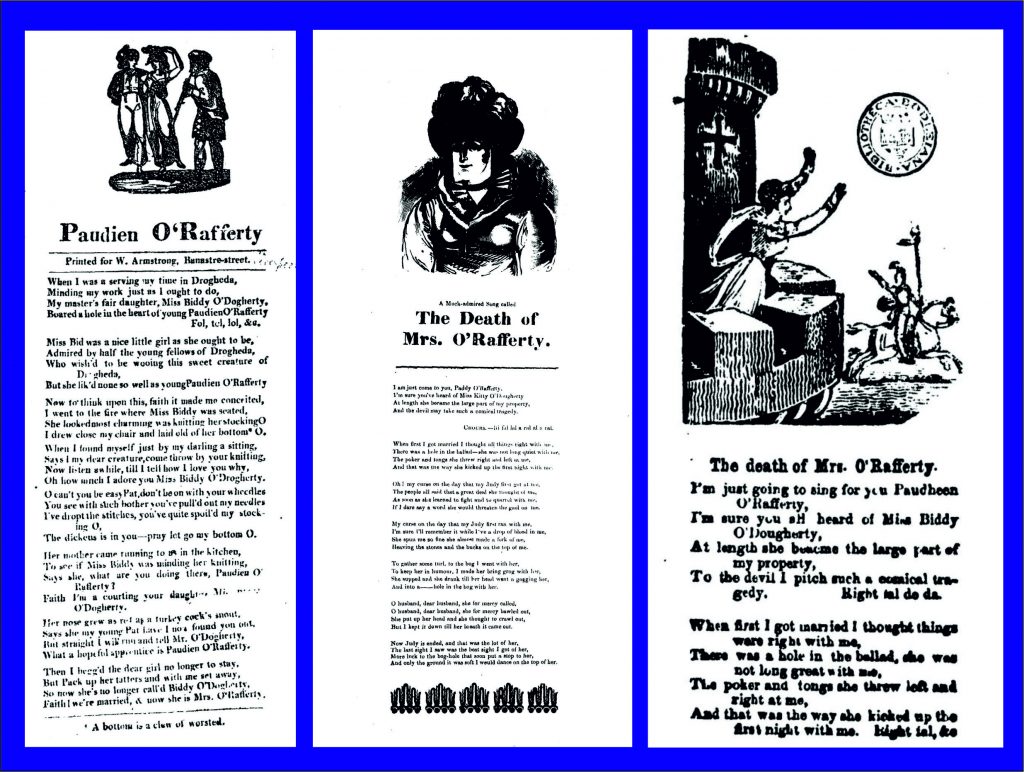
These archives revealed a number of publications – broadsides dating from at least 1820 and songsters from later in that decade – printed in both England and Ireland. There were also some unrelated songs – “to the air of Paddy O’Rafferty” – showing how ubiquitous the tune became. The English and Irish broadside texts fall into two broad groups.
The first concerns Paddy O’Rafferty’s courtship and marriage – as seen in the example on the left, printed in Liverpool
The second group of songs is about how the marriage disintegrates – and ends with Paddy knocking his wife into a bog, burying her and dancing on her grave – as seen on the examples centre and right – the one on the right winning the prize for the most inappropriate woodcut illustration! She certainly could have done with a knight on a white charger, and it certainly wasn’t Paddy O’Rafferty!
Given the lyrics, I’m personally quite glad that these songs don’t seem to have survived much beyond the end of the nineteenth century – singer Elizabeth Cronin from Co. Cork is said to have known a song by the title of Paddy O’Rafferty, but in the book “The Songs of Elizabeth Cronin” Dáibhi Ó Cróinín took a set of words from an un-named ballad sheet (possibly from the Joyce collection), which is the Death of Mrs O’Rafferty song, which gives her name (as do the others here) as Biddy O’Dougherty – conveniently rhyming with “property” …!
The stage song
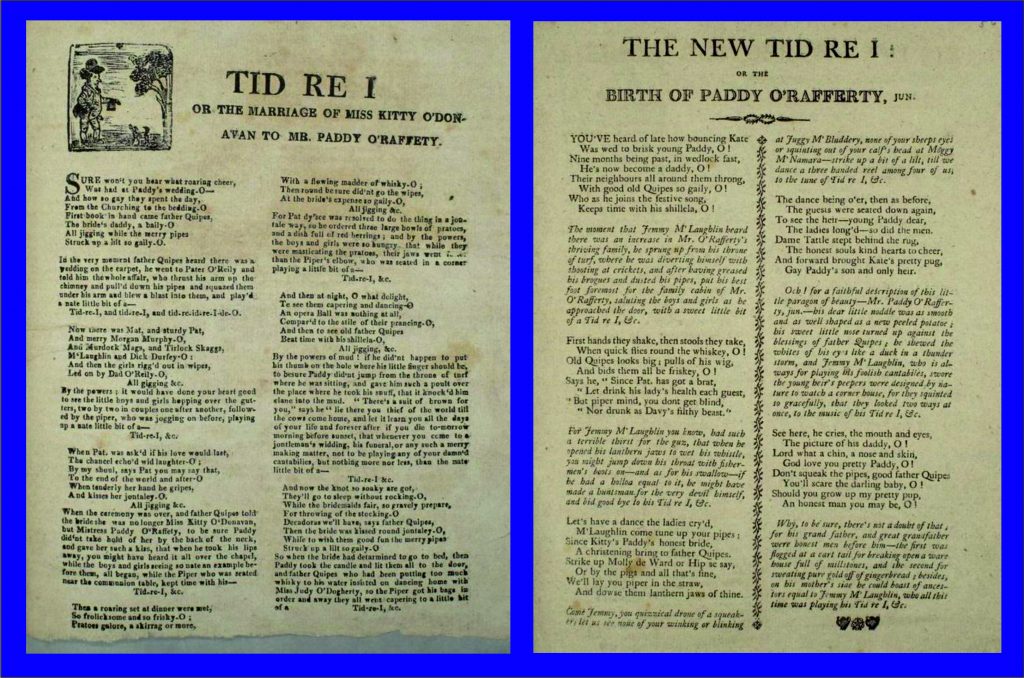
Meanwhile, on the other side of the Atlantic, we find Paddy O’Rafferty marrying another woman! – Kitty O’Donovan – and a completely different set of words, in a cantefable setting. This song – Tid Re I – was printed both as a broadside, and as sheet music with a tune, and it’s not clear which came first.
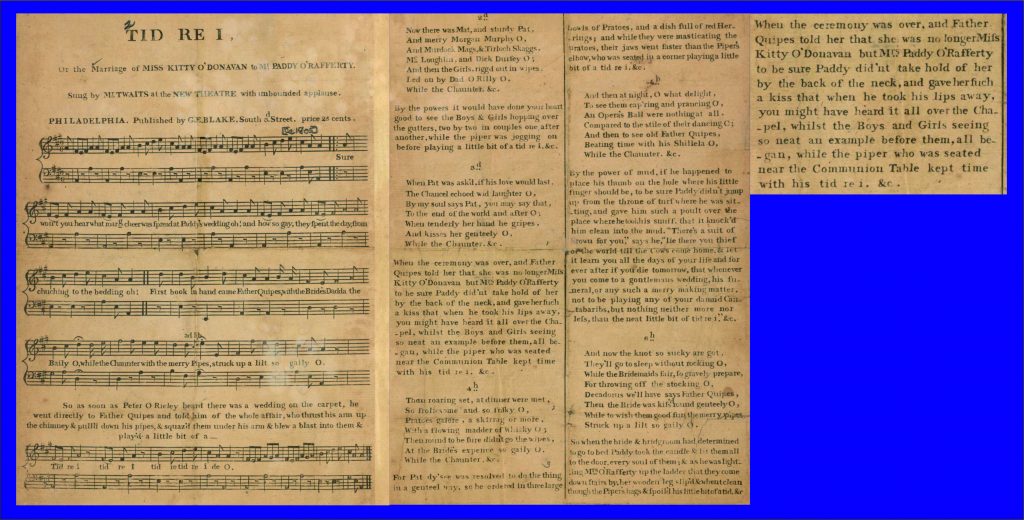
Certainly this song and skit was a big success for the English singer and actor William Twaits, who was engaged for the 1803 winter theatre season in Philadelphia, where this sheet music (above) was published soon afterwards.
So where did these words come from? And is this tune the same as the dance tune? No, of course it’s not, that would be far too straightforward!
Well, once you take off your “folk” binoculars (hopefully not blinkers!) this is when it starts to get even more complex, as the wider context for this song begins to be revealed.
Lack of copyright laws and legislation on what could be staged in different types of performance venues meant that songs, dramatic pieces and stage characters were used and re-used, revived and repurposed. That certainly turns out to be the case with this song Tid Re I, as the verses for this song – without the “patter” were actually written several years before, by the English composer and performer Charles Dibdin. He sang his own composition The Irish Wedding in London at the end of 1796, in a musical revue entitled “The General Election”, in which he interpolated the song with some rather more high falutin’ versification and in his original version, the groom was named only Paddy or Pat and the bride was anonymous.
The stage character and Paddy’s Rambles across the western world
So it’s becoming clear that this character Paddy O’Rafferty had a life on the stage and there is plenty of detail in the newspapers and journals of the early nineteenth century, revealing Paddy O’Rafferty’s rambles around the theatres of England, Ireland and America.
In the period before music hall developed, a night at the theatre consisted of at least three or four separate items which could include a couple of dramatic pieces, maybe a farce or a pantomime, and in the middle, an entr’acte entertainment which might be a stand-alone song or dance item. There was often a prologue or afterpiece as well, so it could be a long night! And almost all plays in the Georgian period included songs, which could be chosen at short notice during a season to suit the character.
It’s in this context that the songs about Paddy O’Rafferty and the stage “character” of Paddy O’Rafferty become increasingly intertwined.
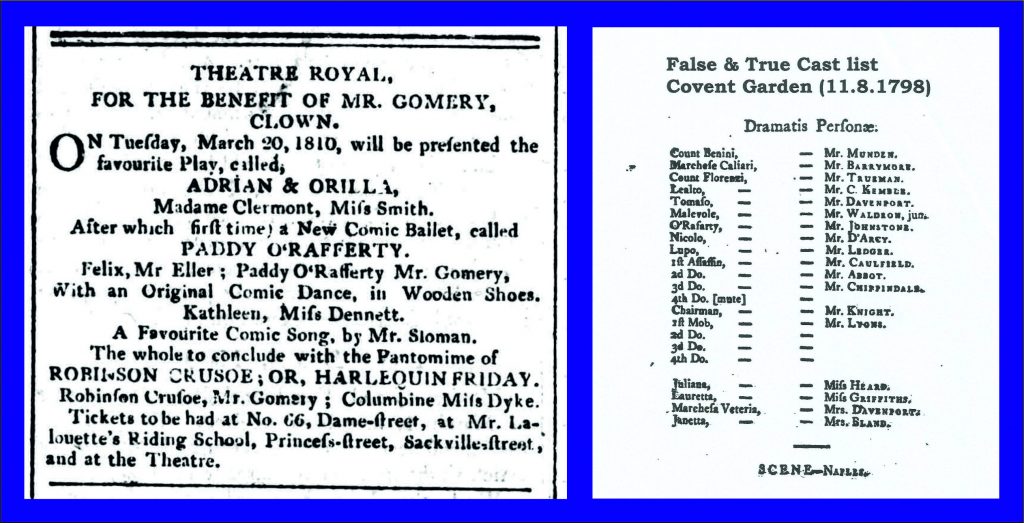
The cast list on the right above, from 1798, shows John Henry Johnstone, an Irish actor, playing the part of Paddy O’Rafferty in a new farce called “False and True” which premiered at Covent Garden, then toured the English provinces – and was staged for the first time in Ireland at the Dublin Theatre Royal in April 1799. Although Johnstone sang songs in this production, none are related to “our song”, but the character has now been established.
From then onwards, Paddy O’Rafferty pops up regularly in the English and Irish theatre, sometimes in a comedy, sometimes in an entr’acte entertainment. The character also toured America. Perhaps the person who really made the part of Paddy O’Rafferty his own, was another Irishman who specialised in playing “Stage Irish” parts in both England and Ireland, the enigmatic Mr. Webb, in the centre below – about whom nothing at all is known, despite a recent trawl of a variety of primary sources – although the details of his 1822 season in Dublin are charmingly revealed in “The Daily Visiter or Companion for the Breakfast Table” published in Dublin.
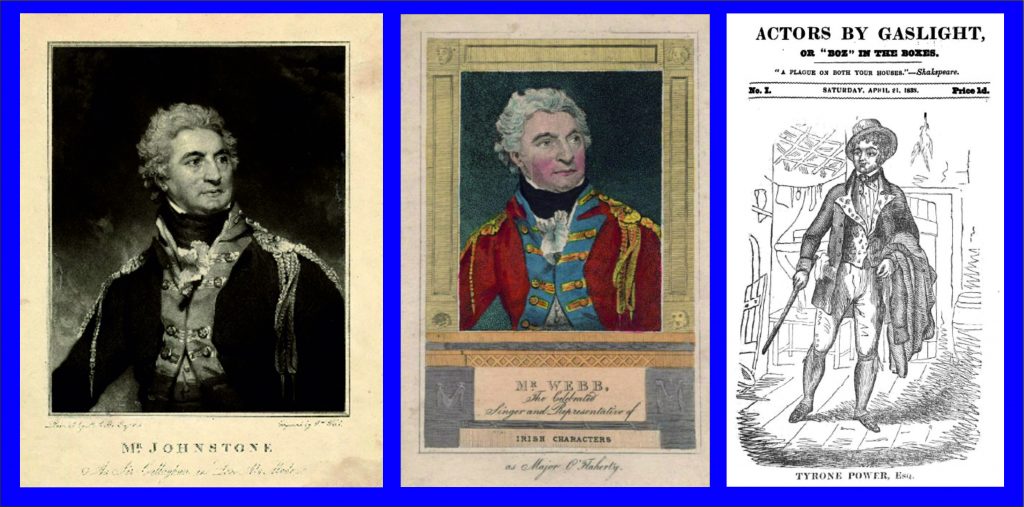
There were a number of plays featuring various stock Irish characters, including Sir Callaghan O’Brallaghan in “Love a La Mode” and Major O’Flaherty in “The West Indian” portrayed here respectively by Johnstone on the left above and Webb in the centre …… hmm!!!
On the right above is another favourite Irish “delineator” Tyrone Power (ancestor of a whole dynasty of American actors with the same name!) who again played all the stock “Stage Irish” parts and took the part of Paddy O’Rafferty many times, notably in his own reworking of the 1798 farce “False and True” into a “new” piece “Born to Good Luck” in 1832.
Many other lesser known actors also played the character of Paddy O’Rafferty during the course of the nineteenth century, in provincial theatres up and down the land.
Summary
So our whistle-stop journey through Paddy O’Rafferty’s kaleidoscopic existence concludes – and here is a brief chronology to round it off.
- The name of a dance tune – in various permutations – first noted aurally in Co. Antrim, printed in England, Scotland, Ireland and the US, and also reproduced on barrel-organs (1795 onwards)
- A proto-Paddy O’Rafferty appeared (as “Paddy” or ”Pat”) as the bridegroom in the song The Irish Wedding written by English composer and performer, Charles Dibdin (1796).
- A “stage Irish” character making appearances in various productions at English, Irish and American theatres (1798 onwards)
- The name of a country dance, used as an opening dance at society balls in England (1801 onwards)
- A character in a cante fable piece Tid Re I (Dibdin’s The Irish Wedding) and a related piece, The New Tid Re I or The Birth of Paddy O’Rafferty junior, both published in the US (1804 onwards).
- A comic dance performed on the stage (1810)
- A character in yet another song; words by Alexander Boswell, set to music, using the traditional air by Beethoven (1814)
- A character in two other songs (Paudeen O’Rafferty and The Death of Mrs O’Rafferty) published on broadsides, in chapbooks and songsters in England and Ireland (circa 1815 onwards)
Conclusions
The recycling of musical themes and titles was incredibly common and means we must have open minds about the relationship between different aspects of popular culture; songs, dances, instrumental tunes, theatrical pieces etc. The link with the stage (and particularly the relationship between London and the Dublin) provides a fertile area for song and tune research.
This talk was originally part of a presentation for the Traditional Song Forum Zoom on 14th June 2020. Although later talks were recorded on YouTube, this was one of the early online meetings before such sophistication!
For further information about Parry’s journeys, the barrel-organ and it’s other tunes, see A Barrel-Organ in the Arctic. See also Esther Gayton part 2: ‘Miss Gayton’s Hornpipe’ . Further explorations of the music on Parry’s barrel-organ are in preparation.
Many of the tunes from Parry’s barrel-organ were recorded following restoration in 1972, and that album is still available on the Saydisc label – “Parry’s Barrel Organ”. It is included on track 2 on the album and was originally on barrel no. 4.
At the time of writing the album is also available to listen to on YouTube via this link. If you want to go direct to the Paddy O’Rafferty tune, it is the third tune out of four on this composite track.
Paul Cooper has done some superb research into Georgian dancing culture and been very helpful in my work on Parry’s barrel-organ. The “research papers” section of his website Regencydances.org is particularly informative.
The English broadside images are from the Bodleian Library’s wonderful Ballads Online resource.
The Tid Re-I song texts are from The American Antiquarian Society’s digital archive.
The portraits of the actors Henry Johnstone and Mr Webb are in the Harvard Theatre Collection and the National Portrait Gallery respectively. These two portraits, supposedly of different people, are nearly identical – although it was very common for engravings to be copied and re-used. John Henry (“Jack”) Johnstone’s stage parts were extremely similar to Webb’s. His portrait is extremely similar to Webb’s in. No personal details are known about Webb at all, except some addresses given for his benefit nights, although he appears in theatrical cast lists regularly from 1801 to 1822. You might expect to read some remarks about Webb following in Johnstone’s footsteps, but I haven’t seen anything. So you might even wonder if they were actually the same person, except a Mr. Webb (though possibly not the same one) and Johnstone appeared on the same stage at Drury Lane in 1805. Further information about Mr Webb in Dublin may be found in “The Daily Visiter or Companion for the Breakfast Table” (1823), digitised on Google Books.
The portrait of Tyrone Power came from the wonderful 1838 publication “Actors by Gaslight”, which together with its sibling “Actors by Daylight” is also digitised on Google Books. (Actors by Gaslight follows Actors by Daylight: Tyrone Power is featured in Volume 1, April 21st 1838, which follows Actors by Daylight December 22nd p. 348.)
The newspaper advert for the “New Comic Ballet” of Paddy O’Rafferty is from Saunders’s News-Letter, 16 March 1810 and advertises a performance at the Theatre Royal in Dublin.
The cast list for the premiere of “False and True” at Covent Garden on 11th August 1798 is taken from the original script by George Moultrie, which is again digitised on Google Books: “False and True”.
Please note: Anyone wishing to cite this original research should credit it to Katie Howson and cite this website as the source. © Katie Howson, 2021.
I have dug out far, far more material on the song, the tune and the stage performances and performers than can be written up here. Please do get in contact if this is a special area of interest or study to you, I would be happy to tell you more.
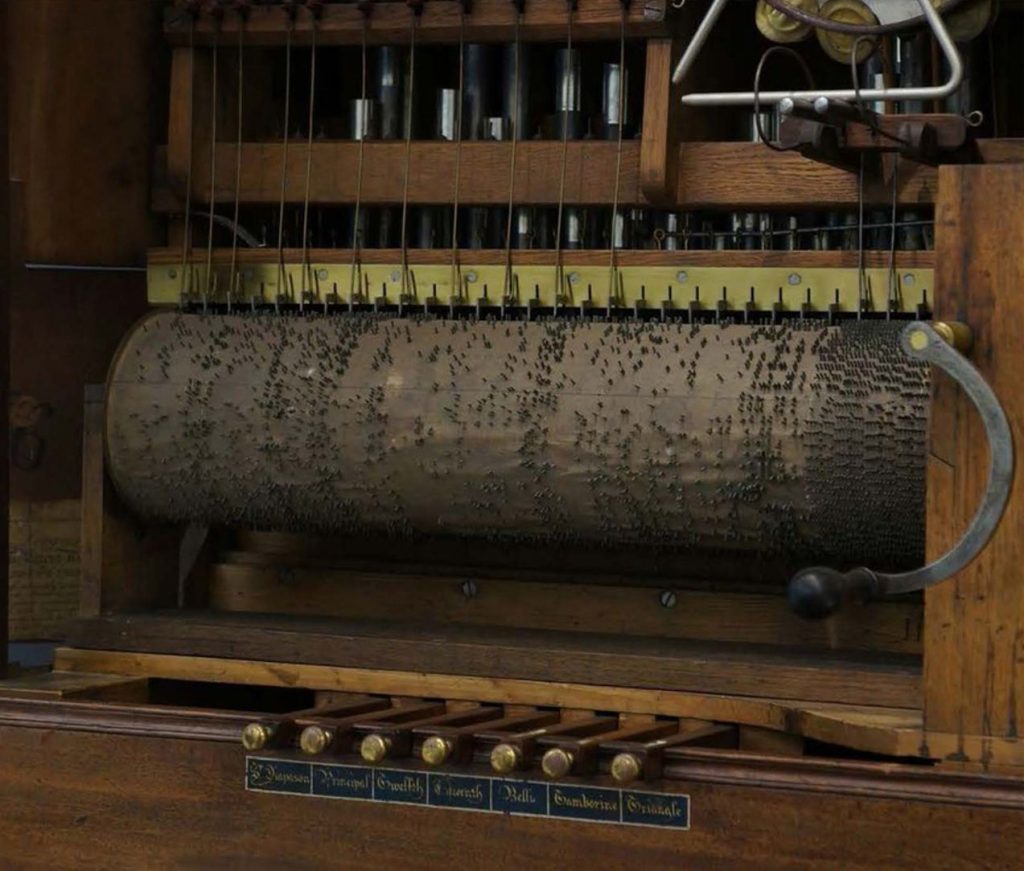 In 1819, Lieutenant William Edward Parry was in charge of an expedition which made a (literal) breakthrough in the search for a North-West passage from the Atlantic to the Pacific. Parry was bold enough to carry on past the point at which his predecessor, John Ross, had turned back, and after 10 months in which his two ships, Hecla and Griper, were stranded by frozen ice, they found a route out. How they passed the time in those long dark days has fascinated me, in particular the idea that he took a mechanical musical instrument, a chamber barrel organ, on board with him.
In 1819, Lieutenant William Edward Parry was in charge of an expedition which made a (literal) breakthrough in the search for a North-West passage from the Atlantic to the Pacific. Parry was bold enough to carry on past the point at which his predecessor, John Ross, had turned back, and after 10 months in which his two ships, Hecla and Griper, were stranded by frozen ice, they found a route out. How they passed the time in those long dark days has fascinated me, in particular the idea that he took a mechanical musical instrument, a chamber barrel organ, on board with him.
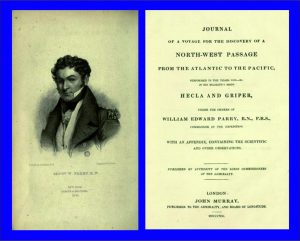 On returning from this first trip Parry was promoted to Commander and subsequently made two further voyages to the Arctic in 1821-23 and 1824-25, and also made an attempt on the North Pole in 1827 which remained the record for the next 49 years. He was knighted in 1829 and eventually attained the rank of Rear-Admiral in the Royal Navy. To find out more about his explorations and achievements, Wikipedia will give you the bare facts, any number of books can fill it out for you, and his journals are also online.
On returning from this first trip Parry was promoted to Commander and subsequently made two further voyages to the Arctic in 1821-23 and 1824-25, and also made an attempt on the North Pole in 1827 which remained the record for the next 49 years. He was knighted in 1829 and eventually attained the rank of Rear-Admiral in the Royal Navy. To find out more about his explorations and achievements, Wikipedia will give you the bare facts, any number of books can fill it out for you, and his journals are also online.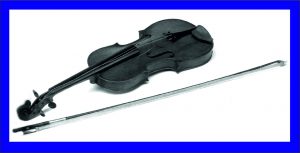 The explorers weren’t totally reliant on mechanical music, as several of the officers on the various voyages were known to be musical, including Parry himself, whose violin is on display in the Maritime Museum in Greenwich.
The explorers weren’t totally reliant on mechanical music, as several of the officers on the various voyages were known to be musical, including Parry himself, whose violin is on display in the Maritime Museum in Greenwich.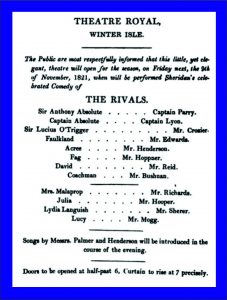 The cast list for The Rivals shown here is from the second voyage, and indicates that men took the women’s parts. Costumes were taken on board specifically for use in theatrical productions and replenished by a donation from the ladies of Bath, Parry’s home town, at one point. After the first voyage, the newspaper idea was dropped, but they then had a Magic Lantern on board for visual as well as musical entertainment – it’s amazing what they found room for on those ships!
The cast list for The Rivals shown here is from the second voyage, and indicates that men took the women’s parts. Costumes were taken on board specifically for use in theatrical productions and replenished by a donation from the ladies of Bath, Parry’s home town, at one point. After the first voyage, the newspaper idea was dropped, but they then had a Magic Lantern on board for visual as well as musical entertainment – it’s amazing what they found room for on those ships!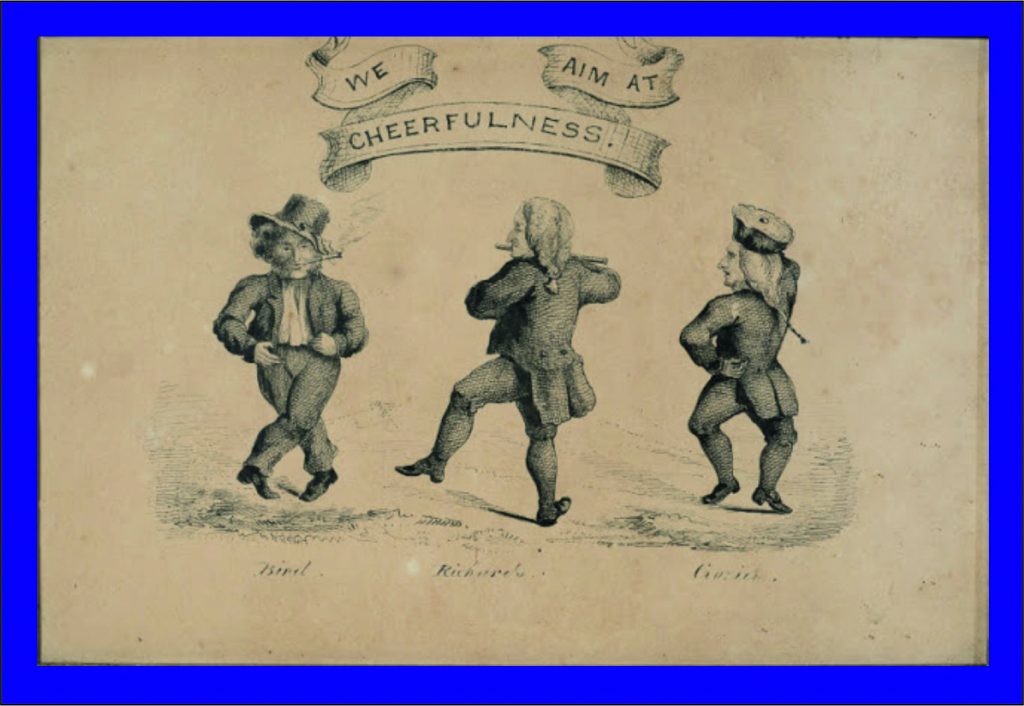
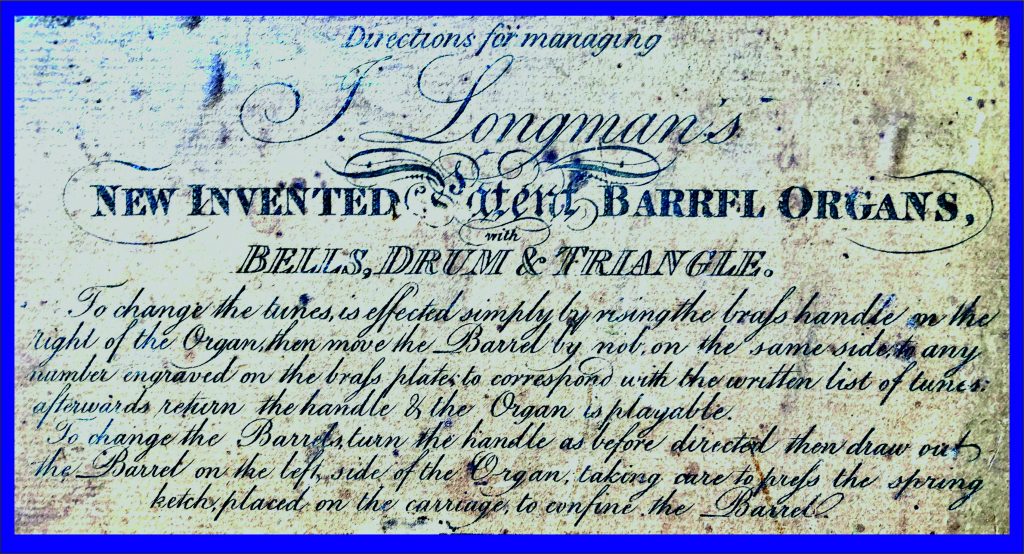
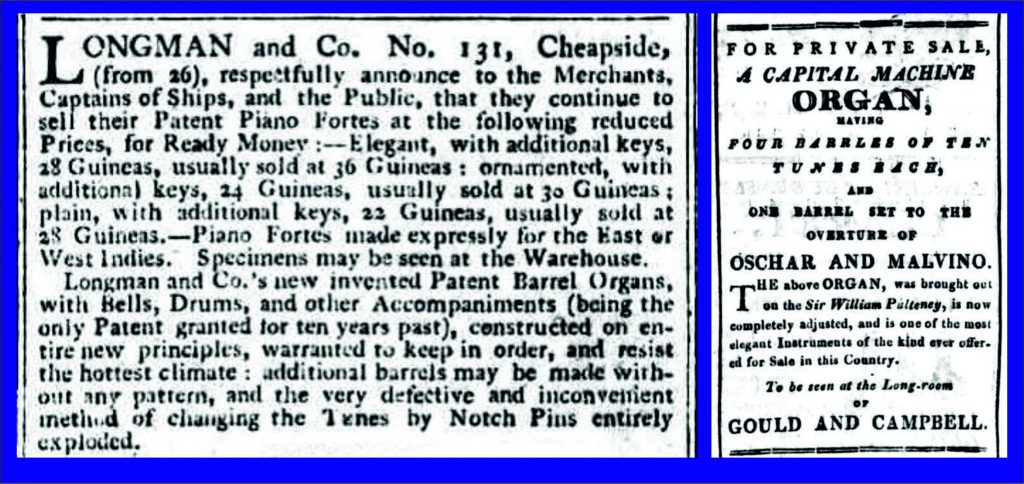
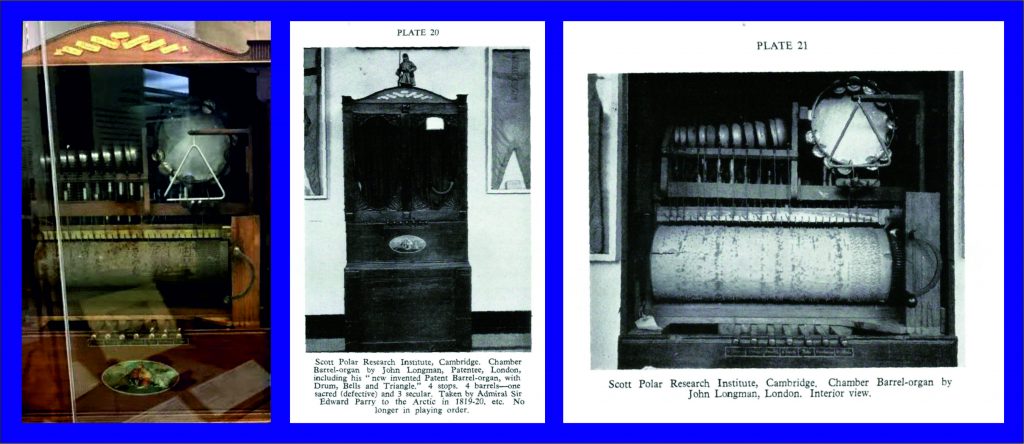
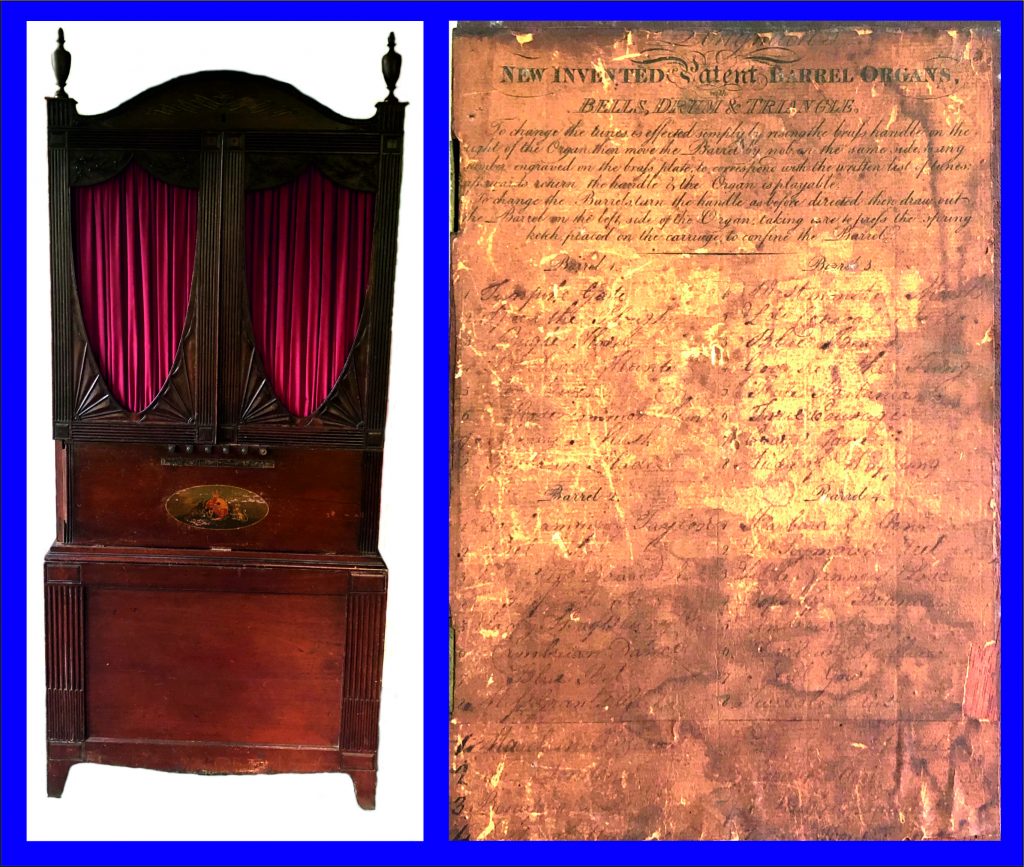
Recent Comments